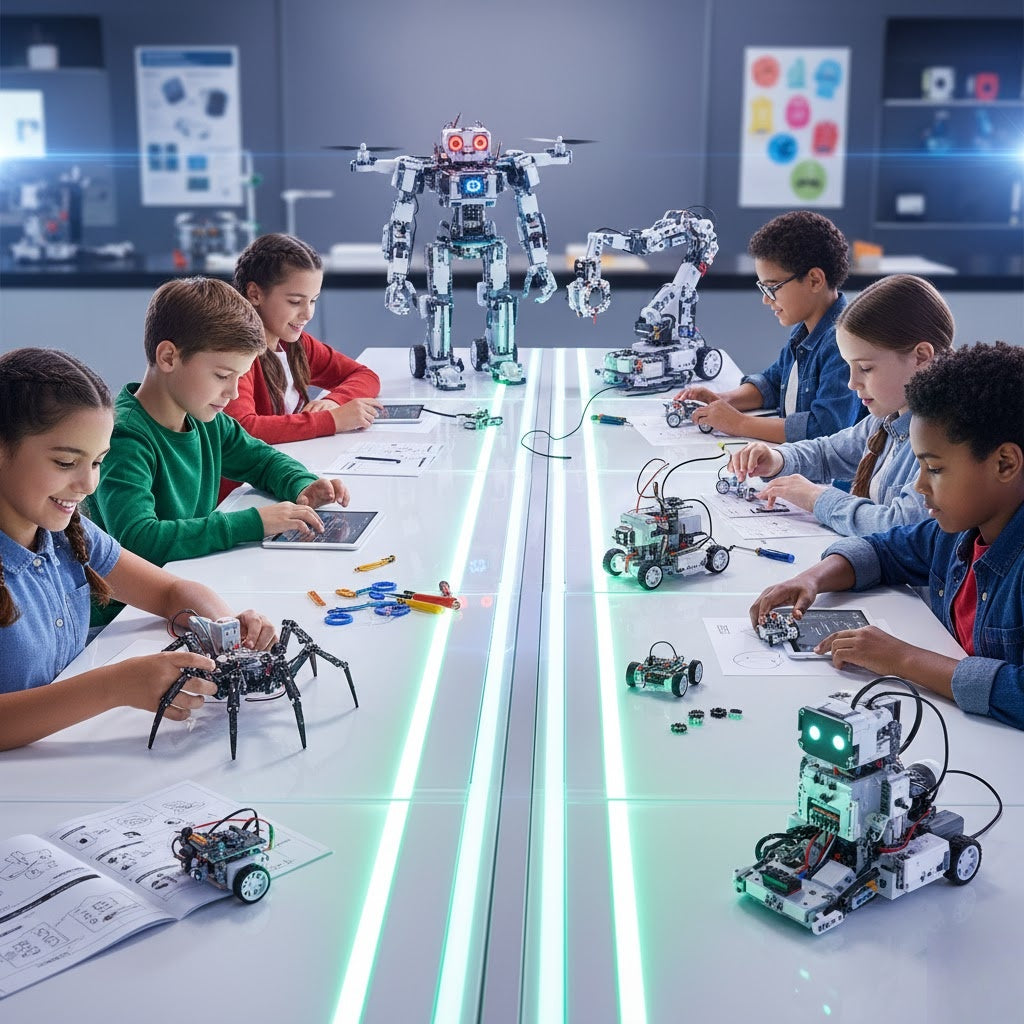
-
Engages Young Minds: When compared to standard approaches, STEM robots have been shown in studies to improve engagement by up to 75%, encouraging lifelong learning.
-
Develops Essential Skills: Early exposure to engineering and programming appears to improve problem-solving skills, though individual outcomes may differ.
-
Inclusive for All Ages: While there is evidence that these tools are flexible, there is debate regarding screen time for very young children; moderation is crucial.
Basics and Classification of STEM Robots

What is a STEM Robot?
Main Types of Robots (by Function and Learning Stage)
-
Construction/Brick-Based Robots (e.g., LEGO): These focus on practical skills and structural understanding. LEGO SPIKE Essential kits allow users to create modular models and learning mechanics and design. Ideal for beginners, they use compatible pieces to spark creativity without advanced coding. For example, users can construct a simple crane to explore leverage, integrating engineering basics.
-
Programming/Educational Robots (e.g., mBot): focus on sensor applications and graphical programming, usually with Scratch. Makeblock's mBot has visual models of loops and scenarios in addition to ultrasonic sensors for obstacle avoidance. These are ideal for transitioning from build to coding, as they take users through experiments such as line-following routes.
-
Advanced/Open-Source Robots (e.g., Arduino/Raspberry Pi): Designed for individuals with basic skills, it provides deep dives into hardware and programming. Arduino kits offer C++ study, but Raspberry Pi-powered robots like as PiCar-X combine AI and computer vision, preparing them for professional use. Users might program a robot arm for precise movements, understanding electronics intimately.
-
Vehicle/Mobility Robots (e.g., Cars, Bionic Robots): These highlight control and kinematics, such as wheeled or tracked motion. Examples simulate autonomous vehicles, teaching dynamics and navigation—perfect for kinetics enthusiasts, like building a robot that mimics animal gaits.
Key Considerations: Finding the "Right" STEM Robot

Target Users and Age Groups
Difficulty and Programming Language Type
Budget and Additional Costs
Course Resources and Community Support
-
Official tutorials: Through LEGO Education, LEGO offers excellent project libraries and step-by-step instructions, along with lesson plans and videos.
-
Community ecosystems: Online forums, user-shared projects, and troubleshooting are crucial. Makeblock's site and Reddit offer vibrant support; Arduino boasts thousands of free tutorials.
-
Evaluate help options: Apps with integrated chat or online academies like Sphero Heroes ensure quick assistance. Without these, devices may gather dust—a pitfall noted in 40% of negative reviews on Best Buy.
|
Consideration
|
Entry-Level (3-6 Years)
|
Mid-Level (7-12 Years)
|
Advanced (13+ Years)
|
|
Focus
|
Sequential thinking, no screens
|
Graphical coding, simple sensors
|
Textual coding, complex hardware
|
|
Example Robot
|
Root Robot
|
mBot Neo
|
Raspberry Pi Kit
|
|
Budget Range
|
40-100 USD
|
100-300 USD
|
200-500+ USD
|
|
Programming
|
Icon-based
|
Block-based (Scratch)
|
Python/C++
|
|
Key Feature
|
Magnetic interaction
|
Obstacle avoidance
|
AI integration
|
|
Community Support
|
Moderate (iRobot forums)
|
High (Makeblock academy)
|
Excellent (Open-source repos)
|
Beginner Recommendations: Popular STEM Robots in 2025
|
Robot Model
|
Age Range
|
Primary Programming
|
Key Features
|
Price Range (USD)
|
Best For
|
|
LEGO SPIKE Essential
|
7-12
|
Block-based
|
Obstacle avoidance, touch response
|
200-300
|
Building fun
|
|
Root Robot
|
4+
|
Iconic to Swift
|
Drawing, color detection
|
100-200
|
Preschool intro
|
|
mBot Neo
|
8-15
|
Blocks to Python
|
Line-following, voice rec
|
100-200
|
Core coding
|
|
Sphero BOLT+
|
8+
|
Blocks/JavaScript
|
AR navigation, animations
|
150-250
|
Interactive play
|
|
Arduino Kit
|
13+
|
C++
|
Sensor arrays, arms
|
50-150
|
Hardware deep-dive
|
|
Raspberry Pi PiCar-X
|
13+
|
Python
|
Facial rec, autonomy
|
200-300
|
AI exploration
|
Low-Threshold Options (Focused on Building and Fun)
-
LEGO SPIKE Essential: This kit replaces WeDo 2.0 and has 449 parts for interactive models.
-
Pros: Include brand awareness, a robust structure, and easy installation.
-
Primary language: Block-based via LEGO app.
-
Key features: Color/motion sensors for tasks such as obstacle-avoiding cars and touch-responsive animals.
-
Age: For 7 to 12.
-
-
Root Robot (iRobot): A magnetic robot for whiteboards, enabling rapid learning.
-
Advantages: Three difficulty levels (icons to text), hands-on play.
-
Primary language: Hybrid, starting iconic to Swift.
-
Features: Draws/erases, detects colors/sounds, climbs surfaces.
-
Age: Recommended age: 4+. 2025 updates add AR integration;
-
Core Programming Options (Graphical as Foundation)
-
Makeblock mBot Neo: Upgraded from classic mBot, with extensive tutorials.
-
Advantages: Affordable, Scratch-like coding, active community.
-
Primary language: Blocks, transitioning to Python.
-
Features: Obstacle avoidance, line-following, basic voice recognition.
-
Age: 8-15.
-
-
Sphero BOLT+: Enhanced BOLT with 2025 firmware.
-
Advantages: Durable sphere, advanced sensors (gyroscope, compass), superb app.
-
Primary language: Blocks or JavaScript.
-
Features: LED matrix animations, precise navigation, AR integration.
-
Age: 8+.
-
Advanced/Open-Source Exploration (for Professional Growth)
-
Arduino/Raspberry Pi Robot Kits: Arduino (e.g., Elegoo Starter) offers high customization.
-
Primary language: C++.
-
Features: Humidity sensors, bionic motion motors, robotic arms.
-
Age: Suited for 13+ with experience.
-
Pitfalls and Common Issues Before Buying
-
Complex Products: Avoid advanced kits with lacking guides, which will bore you; instead, stick to well-known brands.
-
Lack of Support: Skip knockoffs without communities or official maintenance, risking quick obsolescence.
-
Battery Life: Check reviews for endurance, crucial for extended educational sessions.



